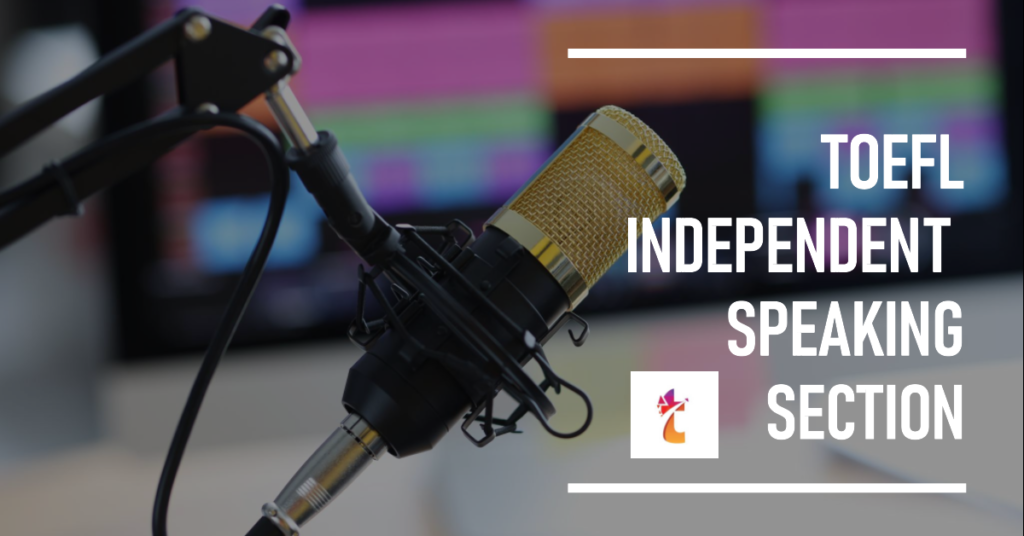TOEFL Independent Speaking SECTION
The independent speaking section of the TOEFL assesses your ability to speak spontaneously and convey your thoughts clearly and coherently. You will be given a prompt and have a short amount of time to prepare your response before recording your answer. Your responses will be evaluated based on the following criteria:

Summary:
1. Delivery (0-4 points): This criterion evaluates your overall speaking delivery, including pronunciation, intonation, pacing, and natural speech flow.
This criterion assesses your overall speaking delivery, including four main aspects:
- Pronunciation: The clarity and correctness of your speech sounds, including vowels, consonants, and word stress.
- Intonation: The rise and fall of your voice while speaking, which contributes to conveying meaning and emphasis.
- Pacing: The speed at which you speak – not too fast or too slow – to ensure clarity and comprehension.
- Natural Speech Flow: The smoothness and fluidity of your speech, avoiding hesitations, interruptions, or overly rehearsed responses.
Example:
Prompt: “Talk about a place you enjoy visiting during your free time. Explain why this place is meaningful to you.”
Response: “One of my favorite places to visit in my free time is a quiet park near my home. It’s a peaceful oasis in the middle of the bustling city. I can relax and unwind there, surrounded by lush greenery and the gentle rustling of leaves. The fresh air and serene atmosphere help me clear my mind and escape from the stresses of daily life.”
Pronunciation: The speaker’s pronunciation is clear and accurate. There are no major pronunciation errors, and each word is easily understandable.
Intonation: The speaker’s intonation rises and falls naturally, emphasizing key points. For instance, “quiet park,” “peaceful oasis,” and “serene atmosphere” are all spoken with appropriate variations in intonation.
Pacing: The speaker maintains a moderate pace throughout the response. They don’t rush through the content, allowing the listener to follow comfortably.
Natural Speech Flow: The response flows smoothly without interruptions or hesitations. The speaker speaks confidently and appears to be expressing their thoughts naturally.
In this example, the speaker’s delivery demonstrates clear pronunciation, appropriate intonation, a moderate pace, and a natural speech flow. These aspects contribute to a well-delivered response that is engaging and easy to understand.
2. Language Use (0-4 points): This criterion assesses your language proficiency, including vocabulary usage, grammatical accuracy, and the variety of sentence structures you use.
This criterion evaluates your language proficiency in three main areas:
- Vocabulary Usage: The range and accuracy of words you use to convey your ideas effectively.
- Grammatical Accuracy: The correctness of your sentence structures and grammar usage.
- Variety of Sentence Structures: The diversity of sentence patterns and structures you employ to create more engaging and coherent speech.
Example:
Prompt: “Discuss a memorable trip you’ve taken. Explain why it was memorable.”
Response: “Last summer, I went on a memorable trip to a charming coastal town. The scenery was breathtaking, with golden sandy beaches stretching along the crystal-clear sea. I remember strolling through the picturesque streets, admiring the vibrant architecture and local crafts. The people I met were incredibly friendly, and their warm hospitality left a lasting impression on me.”
Vocabulary Usage: The speaker demonstrates a strong vocabulary by using descriptive words like “charming,” “breathtaking,” “vibrant,” and “hospitality.” These words vividly paint a picture of the coastal town.
Grammatical Accuracy: The speaker’s sentences are grammatically correct, and there are no noticeable errors in verb tense, subject-verb agreement, or word order.
Variety of Sentence Structures: The speaker employs a variety of sentence structures, including complex sentences (“The scenery was breathtaking, with…”), descriptive phrases (“stretching along the crystal-clear sea”), and compound sentences (“I remember strolling… and local crafts”). This variety adds depth and richness to the response.
In this example, the speaker’s language use is strong, encompassing rich vocabulary, accurate grammar, and a diverse array of sentence structures. These language skills contribute to a well-articulated and engaging response that showcases the speaker’s proficiency in English language use.
3. Topic Development (0-4 points): Here, your ability to fully address the prompt and provide a well-organized, coherent response is evaluated.
This criterion assesses your ability to fully address the prompt and provide a well-organized, coherent response. It includes:
- Addressing the Prompt: Ensuring that your response directly and comprehensively covers the key points of the prompt.
- Organization: Structuring your response in a logical and coherent manner, with a clear introduction, main points, and conclusion.
Example:
Prompt: “Discuss a book or a movie that had a significant impact on you. Include specific details to support your response.”
Response: “The book that has had a profound impact on me is ‘To Kill a Mockingbird’ by Harper Lee. This novel explores themes of racial injustice and moral growth through the eyes of Scout Finch, a young girl in a Southern town. The story takes place during the 1930s, a time of deep racial divides. As Scout observes her father, Atticus Finch, defending a falsely accused black man in court, I was struck by the stark contrast between justice and prejudice. The book taught me valuable lessons about empathy, compassion, and standing up for what is right.”
Addressing the Prompt: The speaker fully addresses the prompt by discussing a specific book (“To Kill a Mockingbird”) and explaining its impact. The focus remains on the book’s influence on the speaker.
Organization: The response is well-organized with a clear introduction (“The book that has had a profound impact on me is…”), main points (“This novel explores themes of racial injustice…”), and conclusion (“The book taught me valuable lessons about empathy, compassion, and standing up for what is right”). The details are presented coherently, leading to a comprehensive and structured discussion.
In this example, the speaker effectively develops the topic by providing a well-organized and coherent response that directly addresses the prompt. The choice of book, the exploration of its themes, and the personal impact are all woven together logically to create a strong and compelling discussion.
4. Support (0-4 points): This criterion focuses on the details and examples you provide to support your ideas. The examples should be relevant, specific, and effectively illustrate your points.
This criterion evaluates your ability to provide relevant, specific, and effective examples and details that illustrate and bolster your main points.
Example:
Prompt: “Discuss an environmental issue you’re concerned about. Provide reasons for your concern and potential solutions.”
Response: “One pressing environmental issue that deeply concerns me is plastic pollution in our oceans. The impact of plastic waste on marine life is alarming. For instance, reports show that millions of marine animals die each year due to ingestion or entanglement in plastic debris. Just last year, a study found that a significant percentage of seabirds had ingested plastic particles, leading to fatal consequences. This devastating effect on marine ecosystems calls for immediate action. Governments and communities around the world need to implement stricter regulations on plastic use, promote recycling programs, and raise public awareness about the importance of reducing plastic consumption. By taking these steps, we can mitigate the harm caused by plastic pollution and protect the delicate balance of our oceans.”
Relevant and Specific Examples: The speaker provides specific examples of the impact of plastic pollution on marine life, such as ingestion and entanglement. These examples help emphasize the severity of the issue.
Effective Illustration: The examples chosen (millions of marine animal deaths, seabird ingestion) effectively illustrate the consequences of plastic pollution and emphasize the urgency of addressing the problem.
Supporting Ideas: The response supports the main points with ideas for potential solutions, such as stricter regulations, recycling programs, and public awareness campaigns. These ideas enhance the depth and comprehensiveness of the response.
In this example, the speaker demonstrates strong support by offering relevant, specific, and impactful examples that enhance the discussion of the environmental issue. The details provided strengthen the overall argument and highlight the importance of addressing plastic pollution.
Study or Download the Rubric Here:
Glossary:
Page 2. Title: Introduction to Independent Speaking
- Function: Provide an overview of the independent speaking section, its format, and scoring criteria.
- Examples: Briefly explain what the independent speaking section entails and highlight the importance of clear communication and well-structured responses.
Page 3. Title: Mastering Delivery and Pronunciation
- Function: Help students improve their pronunciation, intonation, pacing, and overall speaking delivery.
- Examples: Offer audio exercises for practicing pronunciation, provide tips on stress and intonation patterns, and showcase recordings of sample responses with varying levels of delivery.
Page 4. Title: Polishing Language Use
- Function: Assist students in enhancing their vocabulary, grammar, and sentence structures.
- Examples: Present vocabulary-building activities, offer grammar tips and exercises, and share recordings of responses that exhibit strong language use.
Page 5. Title: Developing Compelling Responses
- Function: Teach students how to effectively develop their responses by addressing the prompt comprehensively and organizing their thoughts.
- Examples: Walk through step-by-step approaches to analyzing and understanding prompts, and provide sample responses that demonstrate thorough topic development.
Page 6. Title: Providing Support with Examples
- Function: Guide students on incorporating relevant and specific examples to bolster their ideas.
- Examples: Break down the process of selecting appropriate examples, offer practice prompts with model responses, and encourage students to practice providing supporting details.
Page 7. Title: Practice and Mock Tests
- Function: Offer practice prompts, simulate test conditions, and allow students to record and assess their responses.
- Examples: Provide a variety of practice prompts covering different themes, allow students to record their answers and compare against sample responses, and explain the importance of time management.

